Inaugural Portland Psychedelic Conference 2018
2018 marked an important step in history for Oregon and the communities that support therapeutic use of entheogens. I am grateful to have attended The inaugural Portland Psychedelic Conference. The selection of speakers was varied enough to cover most aspects of the history, current state and future of psychedelics in their function and use. I will write about my experience of each presenter in order of appearance, click on their name to visit their individual websites.
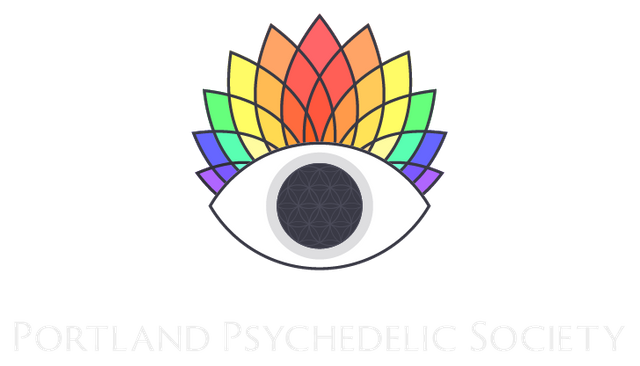
Peter H Addy PhD spoke on phase II and III clinical trials in psychedelic assisted psychotherapy. He referenced Bogenshutz et all 2018 and Stanislav Grof's LSD Psychotherapy. An important point was screening possible participants for medications, schitzophrenia, bipolor or borderline personality which can be exacerbated by psychedelics. Currently due to the illegal nature, therapists can only provide integration using techniques such as holotropic breath-work, internal family systems therapy, somatic therapy, motivational interviewing, and cognitive behavioral therapy. Before he concluded his discussion, he mentioned an ongoing study at this time for MDMA and Cognitive Behavioral Conjoint Therapy.
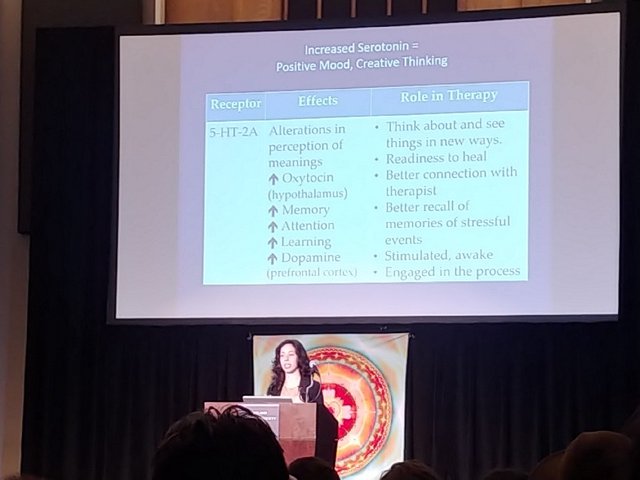
Erica Zelfand, ND took things to a technical level. She went over the 5HT2A receptor and how various substances bind to it, LSD(and ergot) binds in a dense concentration in the high level association regions in the brain. She sited a study detailed below
Using BOLD fMRI to measure the effects of psilocybin on brain activity and connectivity
Investigators: Robin Carhart-Harris PhD, Richard Wise, Amanda Feilding, David Nutt PhD.
Sponsor: Beckley Foundation
Supporting sponsor: MAPS and Heffter Research Institute
Contact: Robin Carhart Harris
This study is part of the Beckley Foundation/Imperial College Psychedelic Research Programme. It aims to discover how psilocin works in the brain by measuring increases and decreases in activity in different regions of the brain induced by the drug. Using analyses of functional and effective connectivity it will reveal network relationships between different regions of the brain and will show whether activity in certain brain regions is exerting a causal or driving influence over activity in other brain regions. These analyses may be very important for understanding the mechanism of action of psilocin. Based on the rationale of psychotherapeutic work with LSD and psilocybin/psilocin in the 1950s and 60s we will also address the hypothesis that psilocin lowers repression and facilitates autobiographical recollection. If this hypothesis is supported it will: 1) indicate that psilocin can facilitate the recollection of autobiographical memories 2) offer a biological explanation for how this occurs and 3) indicate how psilocin might be useful as an adjunct to dynamic psychotherapy.
Then Erica presented the most scientific description of ego dissolution I have heard. I do it a disservice boiling it down to decreased activity in the default mode network and increased connectivity among regions which produces ‘cross talk’. This increased entropy in the brain leads to spiritual experiences. To paraphrase, Psychedelics create a flood of information and destructs the filter. As I listened to her describe it, I theorized that perhaps this is why it helps to heal PTSD, by dissolving the ‘trained brain’ where survival mode has attached itself to everyday responses. She went on to describe the entropic brain hypothesis and how the disorganization of the brain enters someone into child consciousness. Notable mentions during her talk were Francis Crick and the discovery of DNA, as well as the Good Friday Experiment.
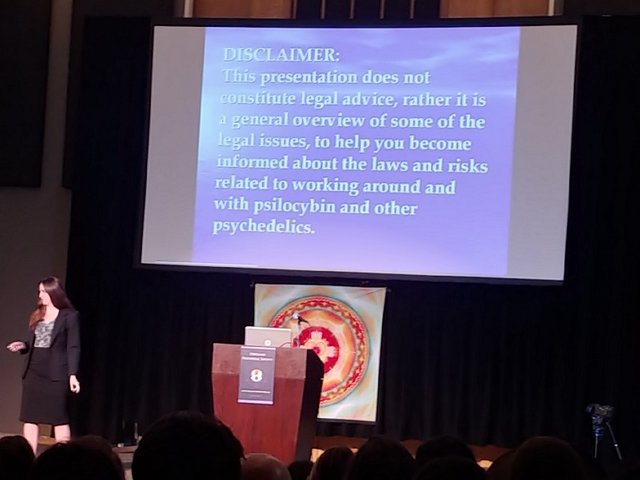
Nicole Dalton JD< brought a necessary topic to the program. She discussed how the law treats psychedelics, what we face with their use at this time, and what resources we have to protect our rights over our own consciousness. The federal, state and county each have their own legislation, and there are also levels of court within each of those factions. The courts interpret laws collectively and with political intention. It all started back at the Convention on Psychotropic Substances in Vienna. In the US the rules fall under Title 21 Ch 13 Sub 1 Part D. Then how do we navigate these dicey waters? With a few specific defenses; Religious Freedom, Free Speech, and Medical Necessity. Religious Freedom can be tricky because the Federal government and the states do not agree on what is covered, or how. Free speech defenses will vary between jurisdictions, and Medical Necessity is a new argument Nicole is preparing to engage with for her clients.
Toward the end of lunch, we were treated to a brief 10 minute cut of The Shaman and the Scientist.
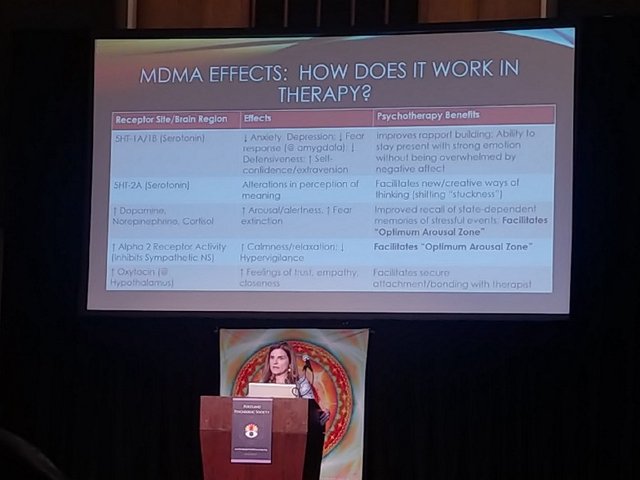
Alissa Dynan Bazinet, PhD gave us a brief history of MDMA. It was created in 1912, used in therapy in the 70's, became a club drug in the 80's and in 1985 was classified as a schedule 1. Trauma is stored in the body, using MDMA and alternative therapies such as somatic, sensor, motor, Hokomi, and Internal Family Systems all for expression of that trauma, in order to process it. She detailed the steps of MAPS clinical trials, Phase III is just beginning. Alissa presented an example video of a veteran who needed to work through PTSD and the rage that it brought out in him. Many subjects at 12 months after the trial no longer had PTSD qualifying symptoms. The Somatic Center Portland is working to acquire Expanded Access (aka compassionate use) to allow for the use of alternative substance therapies. They are currently fundraising to cover the costs of initiation.
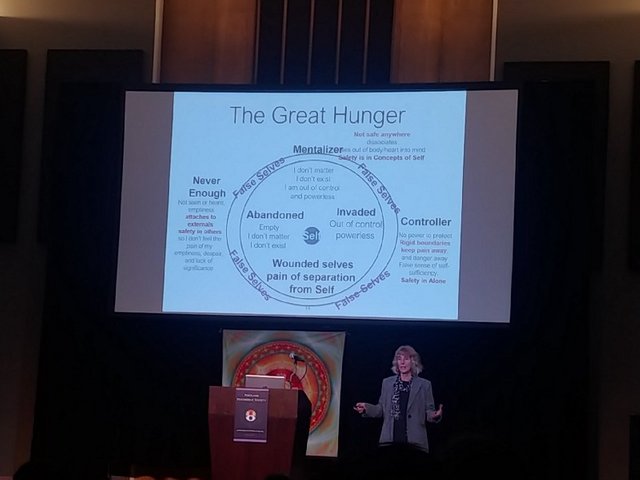
Jane Latimer, MA discussed her therapeutic process utilizing psychedelics. The goal to speed up healing with intelligent use and skillful self work. We got a glimpse of her history that led her to use a conceptual framework of self. The wounded self takes on a false self to avoid the pain, these are the walls of ptsd and depression. The use of psychedelics is an experience of the self, and dis-identification with the false self. Then one must develop skills to embody the authentic self, to live in our authentic presence. Jane warned that although psychedelics are fast, they don’t do the work, it takes active processing of the lessons to dissolve the ego. “You are not your suffering” she stated.
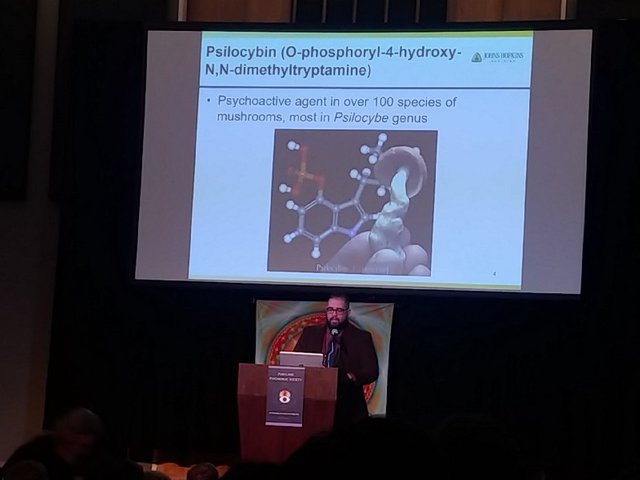
Albert Garcia-Romeu, PhD took us to the root of of psychedelics. The etymology of the word is Greek ‘psyche’ for the mind and ‘delos’ for manifest. Albert participated in the Johns Hopkins Research project sponsored by Heffter and MAPS. According to the NEO Personality Inventory psilocybin increases openness and promotes structural and functional neuroplasticity. They even looked at psilocybin and meditation with healthy people. Johns Hopkins has future trials planned as well.
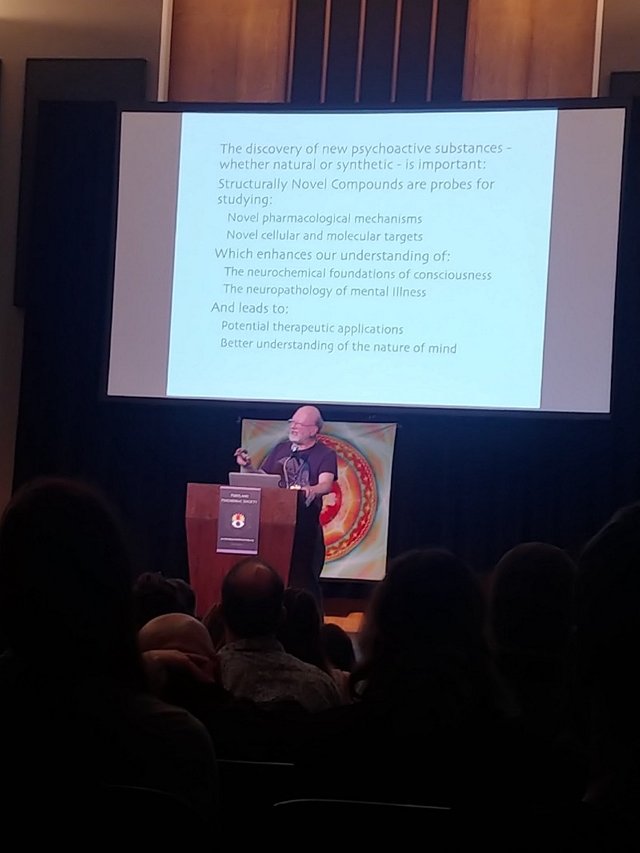
Dennis McKenna, PhD was the keynote speaker, and months before I knew this event was happening I had decided that I would go see him speak at some point in the future, and low and behold, he came to my town! Dennis’s new book titled Enthnopharmacologic Search for Psychoactive Drugs is printed by the synergetic press. This book details the original symposium in 1967 and the recent symposium in 2017, from which many of the lectures are available online. Dennis shared his history of studying entheogens, including his Graduate Thesis which compared Virola(Kookay) to Ayahuasca. In 1993 there was a Hoasca Study Brazil where Platelets results were published in eight peer reviewed publications. This sparked a revival in interest, herbalists in the Amazon have a great variety of remedies. He stated that 80% of the world gets their medicine from here. Dennis went on to detail a number of molecules from entheogens such as Yuramamine; an alkaloid from mimosa hostilis that contains DMT, Harmine which inhibits not only MOA but DYRK 1A and binds to 5HT2A, 2C, and I2R. Other noted enthoegens worth looking into are Salvinorin A which works on opiate receptors, Kava which acts like a social lubricant, iboga whose roots can be chewed for a three day experience, Ibogaine and Kratom which work wonders for opioid problems. Moving away from plants Dennis detailed frogs, fish and insects that have psychedelic substances in them. It was quite an interesting talk and left me interested in more.
I feel that we are approaching critical mass and will soon shift the perspective of psychedelics in our scientific communities and culture. California and Oregon are pushing initiatives to reschedule and legalize psilocybin. PSI 2020 in Oregon is working toward getting a measure on our next ballot. CPLI in California was not able to get the ballot measure for this year, hopefully they will press on to build momentum for the next opportunity. Do you know of any initiatives in your area? Comment and link us to their site.
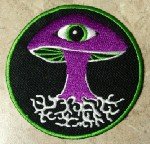
Manic Esoteric

Hi manicesoteric !
Feature being experimented !
After approximatively 48 hours, your post has 2.102 of pending rewards.
To compensate the fact that @share2steem is taking a fee on your posts, please allow us to upvote you via @tipu.
Our fee : 0.210
Value of votes you got from S2S trails : 0.060
Value to compensate : 0.150
!tipuvote 0.150
For the latest news about the Share2Steem application, visit our @share2steem profile.
See you soon on https://www.share2steem.com
This message is generated automatically.
This post is supported by $0.19 @tipU upvote funded by @share2steem :)
@tipU voting service guide | For investors.